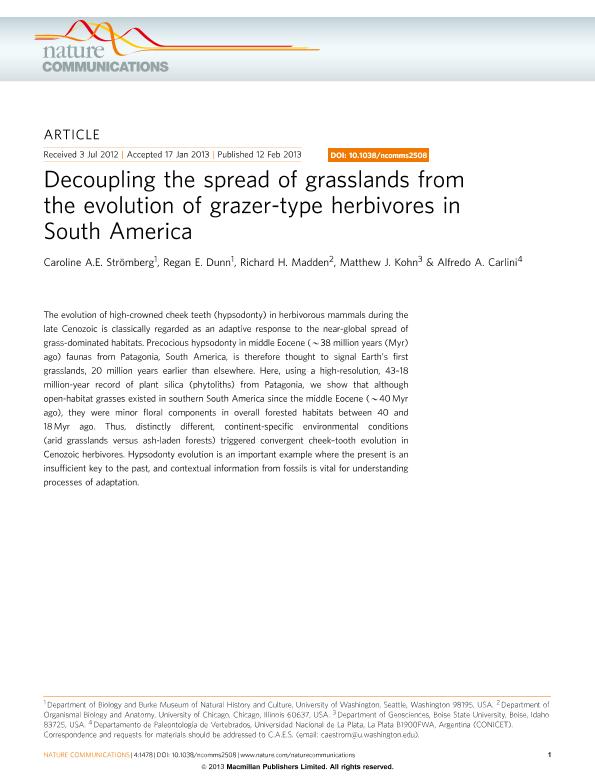Mostrar el registro sencillo del ítem
dc.contributor.author
Strömberg, Caroline A. E.
dc.contributor.author
Dunn, Regan E.
dc.contributor.author
Madden, Richard H.
dc.contributor.author
Kohn, Matthew J.
dc.contributor.author
Carlini, Alfredo Armando

dc.date.available
2017-03-06T19:58:38Z
dc.date.issued
2013-02
dc.identifier.citation
Strömberg, Caroline A. E.; Dunn, Regan E.; Madden, Richard H.; Kohn, Matthew J.; Carlini, Alfredo Armando; Decoupling the spread of grasslands from the evolution of grazer-type herbivores in South America; Macmillan Publishers; Nature Communications; 4; 2-2013; 1-8; 1478
dc.identifier.uri
http://hdl.handle.net/11336/13581
dc.description.abstract
The evolution of high-crowned cheek teeth (hypsodonty) in herbivorous mammals during the late Cenozoic is classically regarded as an adaptive response to the near-global spread of grass-dominated habitats. Precocious hypsodonty in middle Eocene (B38 million years (Myr) ago) faunas from Patagonia, South America, is therefore thought to signal Earth’s first grasslands, 20 million years earlier than elsewhere. Here, using a high-resolution, 43–18 million-year record of plant silica (phytoliths) from Patagonia, we show that although open-habitat grasses existed in southern South America since the middle Eocene (B40 Myr ago), they were minor floral components in overall forested habitats between 40 and 18 Myr ago. Thus, distinctly different, continent-specific environmental conditions (arid grasslands versus ash-laden forests) triggered convergent cheek–tooth evolution in Cenozoic herbivores. Hypsodonty evolution is an important example where the present is an insufficient key to the past, and contextual information from fossils is vital for understanding processes of adaptation.
dc.format
application/pdf
dc.language.iso
eng
dc.publisher
Macmillan Publishers
dc.rights
info:eu-repo/semantics/openAccess
dc.rights.uri
https://creativecommons.org/licenses/by-nc-sa/2.5/ar/
dc.subject
Phytolith
dc.subject
Grasslands
dc.subject
Paleogene
dc.subject
South America
dc.subject.classification
Paleontología

dc.subject.classification
Ciencias de la Tierra y relacionadas con el Medio Ambiente

dc.subject.classification
CIENCIAS NATURALES Y EXACTAS

dc.title
Decoupling the spread of grasslands from the evolution of grazer-type herbivores in South America
dc.type
info:eu-repo/semantics/article
dc.type
info:ar-repo/semantics/artículo
dc.type
info:eu-repo/semantics/publishedVersion
dc.date.updated
2017-03-06T14:07:51Z
dc.identifier.eissn
2041-1723
dc.journal.volume
4
dc.journal.pagination
1-8; 1478
dc.journal.pais
Reino Unido

dc.journal.ciudad
Londres
dc.description.fil
Fil: Strömberg, Caroline A. E.. University of Washington; Estados Unidos
dc.description.fil
Fil: Dunn, Regan E.. University of Washington; Estados Unidos
dc.description.fil
Fil: Madden, Richard H.. University Of Chicago; Estados Unidos
dc.description.fil
Fil: Kohn, Matthew J.. Boise State University; Estados Unidos
dc.description.fil
Fil: Carlini, Alfredo Armando. Consejo Nacional de Investigaciones Científicas y Técnicas; Argentina. Universidad Nacional de La Plata. Facultad de Ciencias Naturales y Museo. Departamento Científico de Paleontología de Vertebrados; Argentina
dc.journal.title
Nature Communications

dc.relation.alternativeid
info:eu-repo/semantics/altIdentifier/doi/http://dx.doi.org/10.1038/ncomms2508
dc.relation.alternativeid
info:eu-repo/semantics/altIdentifier/url/http://www.nature.com/articles/ncomms2508
Archivos asociados
